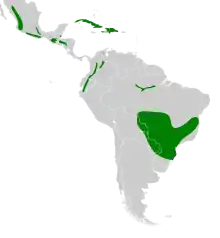Stygian owl
The Stygian owl (Asio stygius) is a medium-sized dusky colored owl. It has yellow eyes, a black beak, a dark blackish facial disk, and white eyebrows. Its underparts are a dingy buff color with dark brown barring and streaks. The upperparts are reverse, buff barring and streaks on a dark background. The adjective "Stygian" means "of, or relating to, the River Styx", but is more widely applied to anything that is dark or dismal.
| Stygian owl | |
|---|---|
.jpg.webp) | |
| Scientific classification | |
| Kingdom: | Animalia |
| Phylum: | Chordata |
| Class: | Aves |
| Order: | Strigiformes |
| Family: | Strigidae |
| Genus: | Asio |
| Species: | A. stygius |
| Binomial name | |
| Asio stygius (Wagler, 1832) | |
 | |
Habitat
This owl occupies a variety of deciduous and evergreen forests, and open areas with patchy forest. It lives at elevations from sea level to 3,100 metres (10,200 ft) above sea level.
Hunting
This species takes in a variety of prey including birds, small mammals, reptiles, amphibians, crustaceans, and insects. All of its hunting is done at night.
Breeding
The Stygian owl lays two eggs in stick nests created by other birds, but occasionally, they will nest on the ground, like their relative, the short-eared owl.
Range and habitat
This owl is not globally threatened, although its status varies greatly throughout its range. It lives in South America, parts of Central America, and the Caribbean, in Cuba and Hispaniola (Dominican Republic and Haiti). It has been documented twice in Texas and once in Florida.[2][3]
References
| Wikimedia Commons has media related to Asio stygius. |
| Wikispecies has information related to Asio stygius. |
- BirdLife International (2012). "Asio stygius". IUCN Red List of Threatened Species. 2012. Retrieved 26 November 2013.CS1 maint: ref=harv (link)
- "Archived copy". Archived from the original on 2007-08-14. Retrieved 2007-08-14.CS1 maint: archived copy as title (link)
- "ABA Rare Bird Alert". Retrieved 2018-08-14.
